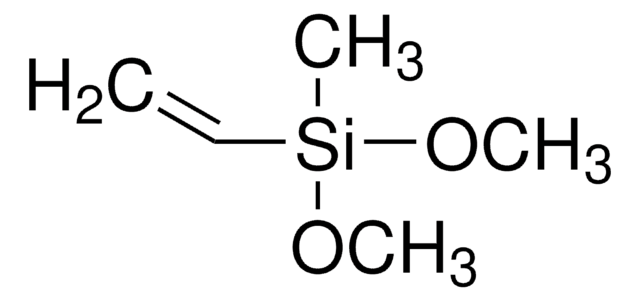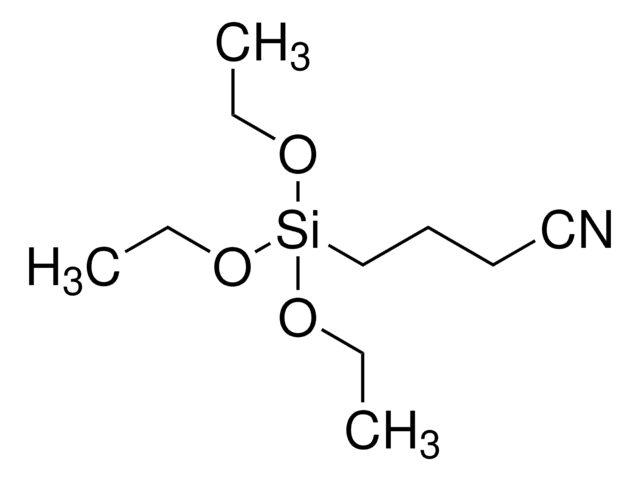539252
3-Glycidoxypropyldimethoxymethylsilane
97%
Sinónimos:
(3-Glycidoxypropyl)methyldimethoxysilane
Iniciar sesiónpara Ver la Fijación de precios por contrato y de la organización
About This Item
Fórmula empírica (notación de Hill):
C9H20O4Si
Número de CAS:
Peso molecular:
220.34
Número CE:
Número MDL:
Código UNSPSC:
12352103
ID de la sustancia en PubChem:
NACRES:
NA.23
Productos recomendados
Nivel de calidad
Ensayo
97%
Formulario
liquid
índice de refracción
n20/D 1.432 (lit.)
bp
100 °C/4 mmHg (lit.)
densidad
1.02 g/mL at 25 °C (lit.)
cadena SMILES
CO[Si](C)(CCCOCC1CO1)OC
InChI
1S/C9H20O4Si/c1-10-14(3,11-2)6-4-5-12-7-9-8-13-9/h9H,4-8H2,1-3H3
Clave InChI
WHGNXNCOTZPEEK-UHFFFAOYSA-N
Descripción general
3-Glycidoxypropyldimethoxymethylsilane (GDMMS) is an epoxy-silane that is used to form a silane based coupling agent for functionalization of a variety of substrates. The epoxy groups allow good adhesion of surface atoms and form a stable polymeric structure.
Aplicación
3-Glycidoxypropyldimethoxymethylsilane (GDMMS) precursor was used to develop zwitterionic push – pull chromophore and carbazole-derivatives-doped hybrid organic–inorganic homogeneous films.{71}
GDMMS can surface modify indium tin oxide (ITO) glass substrate for the immobilization of surface atoms which can be further used for the electrochemical detection and labeling. It can also be used as a hardener in the formation of multi-component silicone based rubber.
The usual cure time is 16-20 hours at room temperature or 1 hour at 100C.
Código de clase de almacenamiento
10 - Combustible liquids
Clase de riesgo para el agua (WGK)
WGK 3
Punto de inflamabilidad (°F)
221.0 °F - closed cup
Punto de inflamabilidad (°C)
105 °C - closed cup
Equipo de protección personal
Eyeshields, Gloves, multi-purpose combination respirator cartridge (US)
Elija entre una de las versiones más recientes:
¿Ya tiene este producto?
Encuentre la documentación para los productos que ha comprado recientemente en la Biblioteca de documentos.
Los clientes también vieron
Headgroup effect on silane structures at buried polymer/silane and polymer/polymer interfaces and their relations to adhesion.
Zhang C, et al.
Langmuir, 28(14), 6052-6059 (2012)
Surface functionalization using catalyst-free azide- alkyne cycloaddition.
Kuzmin A, et al.
Bioconjugate Chemistry, 21(11), 2076-2085 (2010)
Label-free ITO-based immunosensor for the detection of very low concentrations of pathogenic bacteria.
dos Santos MB, et al.
Bioelectrochemistry, 101(11), 146-152 (2015)
Francesca Volpetti et al.
ACS synthetic biology, 6(11), 1979-1987 (2017-08-05)
Synthetically engineered cells are powerful and potentially useful biosensors, but it remains problematic to deploy such systems due to practical difficulties and biosafety concerns. To overcome these hurdles, we developed a microfluidic device that serves as an interface between an
Electro-optics poled sol?gel materials doped with heterocycle push?pull chromophores.
Della Giustina G, et al.
Materials Science & Engineering. C, Materials For Biological Applications, 26(5), 979-982 (2006)
Global Trade Item Number
| Número de referencia del producto (SKU) | GTIN |
|---|---|
| 539252-25ML | 4061837486920 |
Nuestro equipo de científicos tiene experiencia en todas las áreas de investigación: Ciencias de la vida, Ciencia de los materiales, Síntesis química, Cromatografía, Analítica y muchas otras.
Póngase en contacto con el Servicio técnico












